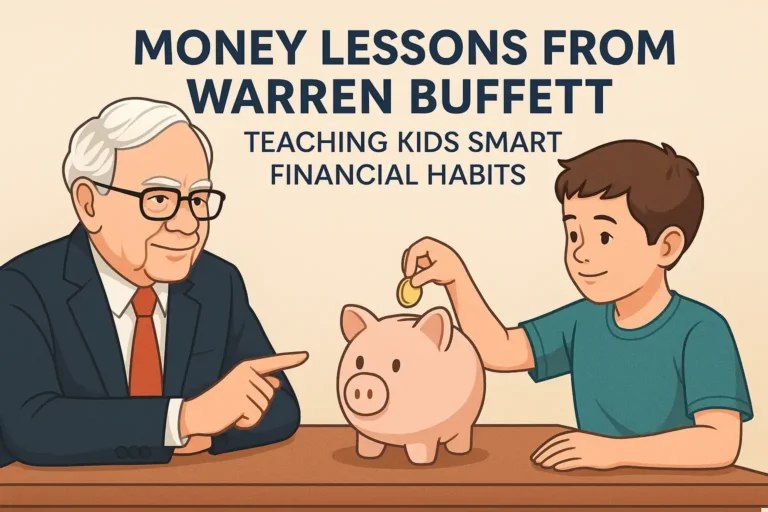Why Buffett’s Approach to Kids’ Money Matters
Imagine your child managing money with the confidence of a future investor—understanding budgets, making smart spending choices, and even thinking about long-term growth. That’s the promise of Warren Buffett allowance rules for children. As someone who gave his first stock tip at age 11 and insisted on financial discipline throughout his life, Buffett’s methods go beyond handing out pocket money.
Rather than treating allowances as mere handouts, Buffett views them as teaching tools—a way to instill a money mindset for children that combines responsibility, patience, and generosity. In this in-depth guide, you will discover Warren Buffett’s rules on spending for kids, learn how to structure allowances for maximum impact, and pick up actionable steps to boost your child’s financial literacy for kids.
1. Structure Allowances Like a Mini 3-Jar System
Primary Concept: Allocate allowances into Spend, Save, and Give.
Buffett believes that money management is a skill best learned early. One key to his success—and that of his own family—is dividing every dollar into distinct jars:
• Spend: For immediate, small purchases
• Save: For medium-term goals (a new toy or game)
• Give: To cultivate generosity and empathy
Why It Works
• Clear Purpose: Your child sees exactly where their money is headed.
• Delayed Gratification: They practice holding off instant wants in the Save jar—an essential saving money habits lesson.
• Empathy Development: The Give jar aligns with Buffett’s advice on teaching kids to give, helping them connect money with kindness.

Action Steps
1. Introduce a Physical Jar System: Label three jars or envelopes.
2. Match Contributions: Consider matching a percentage of what they place in the Save jar—similar to a 401(k) match.
3. Review Weekly: Hold a short “money meeting” to discuss progress, celebrate wins, and set new targets.
2. Cap Spending with Clear Rules on Treats and Toys
Primary Concept: Enforce Warren Buffett’s rules on spending for kids with boundaries on discretionary purchases.
Buffett grew up in a home where his father, a U.S. congressman, didn’t bail him out of poor money choices. Instead, Buffett learned early that every purchase has an opportunity cost.
Key Guidelines
• The 24-Hour Rule: Any discretionary purchase over a set amount (e.g., $5) must wait 24 hours. If the desire remains, it can be approved.
• The Price-Mood Check: Before buying, your child asks: “Does spending this make me feel good now—or will saving make me feel better later?”
Action Steps
1. Set a Spending Threshold: Define what counts as a “big” purchase for your child’s age.
2. Create a “Wish List” Board: They write down items they’d like, then discuss over the week.
3. Honor the Delay: Enforce the waiting period to encourage reflection on wants vs. needs.
This structure builds simple finance rules around impulse control and aligns with Buffett’s belief that “if you buy things you don’t need, you will soon sell things you do need.”
3. Teach Saving and Investing Basics for Children
Primary Concept: Pair savings with investing basics for children to illustrate long-term growth.
Buffett’s own journey began with a purchase of three shares at age 11, and he often emphasizes the magic of compounding. While a full brokerage account may be complex for young kids, there are kid-friendly ways to introduce the concept.
How to Introduce Investing
• Stock-Simulator Apps: Use apps that let children “buy” shares of their favorite brands. They track value without real money risk.
• Custodial Accounts: For older kids, open a custodial brokerage account under parental supervision. Even owning a single share makes them a “company part-owner.”
Action Steps
1. Explain Compound Interest Visually: Show how $10 saved monthly at 5% grows significantly over years.
2. Choose Familiar Companies: Let them pick brands they know—Disney, Nike, or Apple.
3. Discuss Dividends and Growth: Explain that companies share profits (dividends) and reinvest earnings for growth.
By combining allowances with investing basics for children, you reinforce that saving alone is valuable—but investing unlocks even greater potential.
4. Embed Philanthropy: Buffett’s 10% Rule for Giving
Primary Concept: Always allocate at least 10% of allowance or earnings to charity.
Warren Buffett has pledged most of his fortune to philanthropy. He believes generosity enriches character—and research shows giving is linked to happiness.
Structuring Charitable Giving
• Choose Causes Together: Let your child pick charities or community projects they care about.
• Volunteer with Money: Match their Give-jar contributions with volunteer time, reinforcing the value behind donations.
Action Steps
1. Open a “Giving Jar”: Dedicate at least 10% of every allowance cycle.
2. Set Quarterly Goals: Decide on a charity or project every three months.
3. Celebrate Impact: Share how donations are used—photos from food banks, thank-you notes, etc.
This practice ingrains teaching kids to give as a core financial habit and aligns with Buffett’s philosophy that wealth carries responsibility.
5. Reinforce Early Childhood Finance Through Role Modeling
Primary Concept: Model behaviors—children absorb habits by watching parents.
Buffett often credits his father’s consistency: presenting clear, everyday examples of money management. You don’t need to be a billionaire; you just need to be mindful.
Modeling Traits to Exhibit
• Budget Transparency: Share age-appropriate aspects of household budgeting—grocery costs, utility bills, etc.
• Mistake Discussions: Talk openly about impulse buys you regret and lessons learned.
• Goal Tracking: Show them your saving and investing goals (like Buffett tracking Berkshire Hathaway progress).
Action Steps
1. Involve Kids in Simple Decisions: Choose between two grocery brands based on price and quality in front of them.
2. Discuss Weekly Wins/Setbacks: Make money conversations a normal part of family life.
3. Lead by Example: Keep your own spending and saving aligned with the simple finance rules you teach.
By integrating early childhood finance into daily routines, you mirror Buffett’s lifelong dedication to continuous learning and discipline.

🧠 Bonus Tips: Warren Buffett’s Parenting Rule Is the Key To Raising Financially Savvy Kids
💡 Bonus Tips: Applying Warren Buffett’s Allowance advice for Kids at Home
Buffett’s wisdom is not reserved for billionaires. These extra, parent-tested tips help apply Warren Buffett allowance rules for children practically at home.
✅ 1. Use a “Money Day” Each Week
Set one day a week (like Friday) as Money Day—when allowance is given, savings are counted, and goals are updated. This turns routine into a learning ritual.
Children learn by doing, and consistency builds habits—the foundation of Buffett’s success.
✅ 2. Introduce Real-Life Examples from Buffett’s Childhood
Buffett sold gum and Coca-Cola at age six. Share this with your kids and encourage them to think of small business ideas. This introduces Buffett investment philosophy and early childhood finance concepts.
✅ 3. Connect Their Allowance to Goals
Instead of vague savings, tie their savings to something real: a book, a toy, or even charity donations. Let them visualize progress using charts, which makes saving money habits fun.
✅ 4. Model the 10% Giving Rule
Buffett is a quiet philanthropist. Teach kids to give 10% of their allowance to a cause of their choice. This aligns with teaching kids to give, while developing empathy and financial intention.
✅ 5. Celebrate Financial Milestones
Whether they reach a savings goal or choose to wait on a purchase—celebrate progress. Use praise and small rewards to reinforce behavior.
“Positive reinforcement” is a hidden gem in Warren Buffett’s rules on spending for kids.
✅ 6. Keep Conversations Open
Ask your child questions like:
• “What are you saving for now?”
• “Did anything you spent on this week make you regretful or happy?”
• “Would you change anything in how you spent or saved this week?”
These open-ended talks develop money mindset for children and help shape independent decision-making.
✅ 7. Use Apps for Digital Natives
Use family finance apps like RoosterMoney, Greenlight, or BusyKid to make tracking allowance digital. These tools help modernize Buffett’s traditional rules while teaching financial literacy for kids in a format they enjoy.
❓ FAQs (Frequently Asked Questions)
❓1. What age should I start using Warren Buffett’s allowance rules for children?
You can start as early as age 5, especially with the basics like saving and giving. By age 7, children can understand simple jars or digital trackers. This aligns with early childhood finance research showing money habits form early.
❓2. How much allowance should I give weekly?
A general guide: $1 per year of age. A 10-year-old could receive $10 weekly, divided across spend/save/give jars. But adjust based on your household income and teaching goals.
❓3. Should allowance be tied to chores?
Warren Buffett doesn’t directly advocate linking chores to money. Experts suggest splitting chores into:
• Expected responsibilities (no pay)
• Extra contributions (earnings allowed)
This approach teaches simple finance rules and responsibility simultaneously.
❓4. What if my child spends all their allowance quickly?
That’s actually a teachable moment. Let them run out—don’t refill their jar. Then review the week together:
• What did they spend on?
• Would they make the same choice again?
This approach supports Warren Buffett’s rules on spending for kids, emphasizing accountability.
❓5. How can I teach investing using my child’s allowance?
Start with fractional shares using custodial accounts or apps like Stockpile. Choose companies they know—Disney, Lego, Apple. Track progress monthly. These are excellent investing basics for children.
❓6. What if they don’t care about saving or giving?
That’s normal. Start small:
• Share stories about how saving helped you.
• Match their savings or giving efforts.
• Involve them in choosing where to donate (animal shelter, kids hospital, etc.).
These actions build habits aligned with grandchildren investing tips and Buffett’s legacy mindset.
❓7. What if I’m not good with money myself?
You don’t need to be Warren Buffett to raise a child who’s financially smart. Learn together. Watch Secret Millionaires Club episodes, read money books, and apply one new rule each month.
❓8. How can I make allowance teaching fun?
Gamify it! Use reward charts, milestone badges, or mini-financial quizzes. For example:
• “Can you save $10 in 2 weeks without skipping your 10% Give jar?”
• Use Monopoly money to role-play real-life scenarios.
❓9. How often should I review allowance habits?
Weekly check-ins are ideal. Discuss:
• What they spent
• How much they saved
• Any giving done
This builds self-awareness and consistency.
❓10. Can I apply Buffett’s allowance rules to teens?
Absolutely. Just scale it:
• Increase responsibility: groceries, mobile bills, clothing budgets.
• Introduce topics like compound interest, inflation, or retirement plans.
By teenage years, this morphs into Buffett investment philosophy preparation.

🧠 “Money Mirror” – Reflect Weekly with Your Child
(Use this 4-question journaling prompt at the end of each week)
1. What did I spend my money on this week?
• Write down everything. This builds awareness.
2. What’s one thing I could have saved instead of spent?
• Encourages budgeting and delayed gratification.
3. How did I feel when I gave to others or saved money?
• Emphasizes emotional awareness and connection to generosity.
4. What’s one small money goal for next week?
• Could be saving $5, giving $1, or skipping a snack to save.
This weekly reflection aligns beautifully with money mindset for children, forming the cognitive habits Buffett champions.
⚠ Common Mistakes
❌ 1. Giving Allowance Without Guidance
An allowance without structure is just pocket money. Kids need rules—Warren Buffett allowance rules for children include spending wisely, giving, and saving intentionally.
❌ 2. Overcompensating or Overcorrecting
If they overspend, don’t shame. If they save a lot, don’t restrict. Guide behavior through reflection, not control.
❌ 3. Forgetting to Model Behavior
You can’t expect kids to save if they see you impulsively shopping. Children mimic actions before they follow instructions. Be the Buffett you want your child to become.
❌ 4. Ignoring Financial Failures
Let them make small mistakes now. Better to blow $5 at age 8 than $500 at age 28. Mistakes make better money mentors than lectures.
Conclusion: Empower a Generation with Buffett’s Allowance Principles
Warren Buffett allowance rules for children and Warren Buffett’s rules on spending for kids aren’t rigid mandates—they’re flexible frameworks you adapt for your family. Through a structured allowance system, clear spending boundaries, saving and investing fundamentals, charitable giving, and role modeling, you’re giving your children a priceless gift: a solid money mindset for children.
Start today by implementing just one rule—whether it is the three-jar system or the 24-hour spending pause—and watch your child grow into a confident, financially savvy individual. Remember, the best time to teach money skills is now. Your deliberate actions today will shape your child’s financial future for decades to come.
🔗 Next Steps & Resources
• Subscribe to TheFitFinance Newsletter for ongoing parenting and finance insights.
• Share this post with fellow parents eager to build a foundation of wealth wisdom for the next generation.
As you understood Buffett’s Money Wisdom, then you should also learn this > Why Your Emergency Fund Deserves a High-Yield Savings Account (and How to Get Started Today) – The Fit Finance
By weaving financial literacy for kids, children’s allowance tips, and investing basics for children into everyday life, you are not just teaching money—you’re sculpting future leaders. Empower your family with Buffett’s wisdom and watch them thrive!






